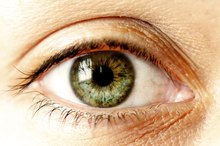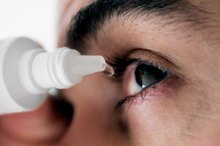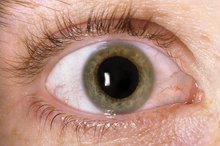What does fact checked mean?
At Healthfully, we strive to deliver objective content that is accurate and up-to-date. Our team periodically reviews articles in order to ensure content quality. The sources cited below consist of evidence from peer-reviewed journals, prominent medical organizations, academic associations, and government data.
The information contained on this site is for informational purposes only, and should not be used as a substitute for the advice of a professional health care provider. Please check with the appropriate physician regarding health questions and concerns. Although we strive to deliver accurate and up-to-date information, no guarantee to that effect is made.
The University of Maryland Medical Center describes an eye cold, also called pink eye or conjunctivitis, as an inflammation or infection of the membrane that lines the eyelids. This inflammation can cause the eye's blood vessels to become more prominent, giving the whites of the eyes a pinkish hue. Several factors can lead to an eye cold, most commonly a bacterial or viral infection or allergic reaction. Depending on the type of infection, antibiotics may be needed. Over-the-counter medicines and self-care measures may also provide relief 2.
Treatments for Bacterial Conjunctivitis
Bacterial conjunctivitis is a type of eye cold, affecting one or both eyes. The infection often produces a thick, yellowish discharge, and according to the Mayo Clinic, may be associated with a respiratory infection or sore throat 2. Antibiotic treatments are often prescribed for bacterial conjunctivitis, given in the form of an eye drop, or for children, an ointment, as it is sometimes easier to administer. Both forms of the medication work quickly, improving symptoms in a few days. Taking the full course of the medicine is important to reduce recurrence of the eye cold.
- Bacterial conjunctivitis is a type of eye cold, affecting one or both eyes.
- The infection often produces a thick, yellowish discharge, and according to the Mayo Clinic, may be associated with a respiratory infection or sore throat 2.
Tretaments for Viral Conjunctivitis
Cold in the Eye Symptoms
Learn More
Like bacterial conjunctivitis, viral conjunctivitis can affect one or both eyes, and may also be associated with a cold. However, the discharge appearing with a viral eye cold is watery or of a mucous consistency. Because viral eye colds do not respond to antibiotics, an over-the-counter remedy may be used to reduce symptoms, but will not cure the infection. Talk to a pharmacist about the best treatments for you. The Mayo Clinic maintains the infection must run its course, often worsening in the 3 to 5 days before gradually clearing 2. The infection may last several weeks before you are fully recovered.
- Like bacterial conjunctivitis, viral conjunctivitis can affect one or both eyes, and may also be associated with a cold.
- Because viral eye colds do not respond to antibiotics, an over-the-counter remedy may be used to reduce symptoms, but will not cure the infection.
Allergic Eye Cold Treatments
Another type of eye cold is allergy-related. Treatments include a variety of eye drops. According to the Mayo Clinic, prescription eye drops for allergic conjunctivitis include decongestants, antihistamines (as cell stabilizers), steroids and anti-inflammatory drops 12.
Considerations
Vitamins for an Eye Stye
Learn More
No matter what the cause of your eye cold, you can sooth the symptoms with self-care measures 2. Consider applying a warm compress to the infected eye, using a clean damp cloth. You can calm an allergic eye cold with a cool compress, taking care not to rub the eyes and release more histamine.
- No matter what the cause of your eye cold, you can sooth the symptoms with self-care measures 2.
- You can calm an allergic eye cold with a cool compress, taking care not to rub the eyes and release more histamine.
Warning
Viral and bacterial eye colds are highly contagious so it is important to seek prompt treatment for your infection. In addition, rubbing or touching your eyes can spread the infection from one eye to the other, or to other individuals. Women should refrain from wearing make-up while the infection is present and throw away any old makeup to reduce the risks of re-infection.
Related Articles
References
- The Mayo Clinic/ Types (causes) of Pink Eye
- The Mayo Clinic/ Self-Care Measures
- Centers for Disease Control and Prevention. Conjunctivitis (Pink Eye): Causes. Updated January 4, 2019.
- Meyer-rüsenberg B, Loderstädt U, Richard G, Kaulfers PM, Gesser C. Epidemic keratoconjunctivitis: the current situation and recommendations for prevention and treatment. Dtsch Arztebl Int. 2011;108(27):475-80. doi:10.3238/arztebl.2011.0475
- National Eye Institute. Facts About Pink Eye. Updated November 2015.
- Azher, T.; Yin, X.; Tajfirouz, D. et al. Herpes simplex keratitis: challenges in diagnosis and clinical management. Clin Ophthalmol. 2017; 11:185-91. doi:10.2147/OPTH.S80475
- Goodman, D.; Rogers, J.; and Livingston, E. Conjunctivitis. JAMA. 2013; 309(20):2176. doi:10.1001/jama.2013.4432
- Palafox S.; Jasper, S.; Tauber, A. et al. Ophthalmia Neonatorum. J Clinic Experiment Ophthalmol. 2011; 2:119. doiI:10.4172/2155-9570.1000119.
- National Eye Institute. Cornea | Giant Papillary Conjunctivitis (GPC).
- Zikic A, Schünemann H, Wi T, Lincetto O, Broutet N, Santesso N. Treatment of Neonatal Chlamydial Conjunctivitis: A Systematic Review and Meta-analysis. J Pediatric Infect Dis Soc. 2018;7(3):e107-e115. doi:10.1093/jpids/piy060
Writer Bio
A health-care professional for more than 10 years, Rica Lewis has obtained numerous certifications in the industry. In 2006 she began channeling her knowledge into health-related articles for print and online publications. Her work has appeared in "Metroparent Magazine," "Anew Heart Healthcare Magazine" and community newspapers. Lewis earned a diploma from LongRidge Writers Institute.









